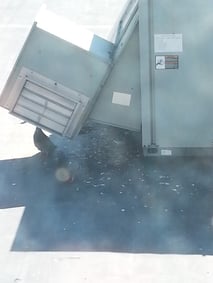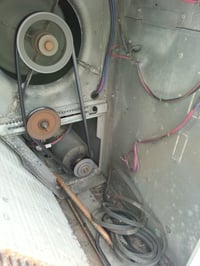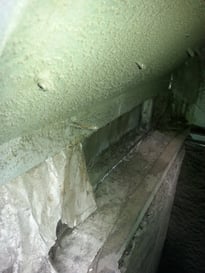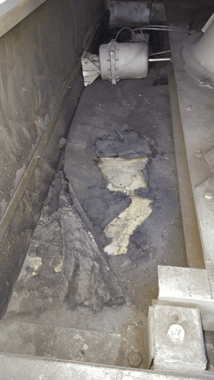Indoor air quality complaints from employees can be quite common in office environments. Symptoms such as red or itching eyes, cough, colds, allergies, headaches and unusual odors are some of the issues that can be reported by building occupants. In the course of investigating contributing causes, a review of the buildings use history, inspection of the immediate complaint area and measurement of various airborne contaminants may not reveal a likely source. This is when a trip to the air handling unit (AHU) on the roof becomes necessary.
Building maintenance staff will assume the AHU is well maintained because “filters are changed quarterly,” however, while clean filters are integral to operation of the AHU, they are only one component of an AHU’s health. The entire AHU, from outdoor air intake to discharge into the building, supply ducts, and return ducts all warrant inspection to identify problems.

Photo 1 - Pigeon rooting under outdoor air intake.
Occupants of the building depicted in Photo 1 were experiencing a headaches, respiratory irritations and bloody noses. Inside the building, the offices seemed to be in good shape, however, when the AHU on the roof was inspected, they found pigeons rooting under the outdoor air intake. Feathers had somehow by-passed the filters and were found throughout the unit. Pigeon droppings were also covering the roof. Bird feather and dust allergies, bacterial and fungal infections are some potential hazards of birds impacting the AHU. Cleaning and disinfecting the AHU, followed by physically blocking access to the AHU were necessary, as pigeons can be persistent in returning to their roosting area.
 Photo 2 - Trash disposed of inside AHU.
Photo 2 - Trash disposed of inside AHU.
Mechanical hygiene is an important part of maintaining a complaint free building. It is pretty eminent that the HVAC maintenance contractor of the building in Photo 2 had been disposing of used belts and other trash inside the AHU. Poor maintenance practices, such as this, can indicate other corners are bring cut when it comes to other requirements of the maintenance contract.
When it comes to mechanical hygiene, ACR 2006 Assessment, Cleaning, and Restoration of HVAC Systems, National Air Duct Cleaners Association states “An interior surface is considered visibly clean when it is free from non-adhered substances and debris”. Indoor dusts are a mixture of plant pollen, human and animal hairs, textile fibers, paper fibers, soil minerals, human skin cells, degraded building materials, and even worn tire rubber when located near a major highway. Dust accumulations like those in Photo 3, from an AHU where filters were changed quarterly, create the potential for dust-related allergies and/or bacterial and fungal growth to impact building occupants.
 Photo 3 - Dust and debris on internal AHU surfaces.
Photo 3 - Dust and debris on internal AHU surfaces.
Ripped and torn fiberglass insulation (Photo 4) and confirmed mold growth on internal AHU surfaces (Photos 5 & 6) contribute to exposure and reported complaints by building occupants. In these instances, the AHU was reported as well maintained by the responsible HVAC Contractor, however, our inspection revealed the opposite and indicates that a HVAC contractor may not be the best source to evaluate their own performance.
 Photo 4 - Ripped torn fiberglass insulation inside AHU.
Photo 4 - Ripped torn fiberglass insulation inside AHU.
 Photo 5 - Confirmed mold growth on internal AHU insulation.
Photo 5 - Confirmed mold growth on internal AHU insulation.

Photo 6 - Dust, debris and confirmed mold growth on supply fan and fan housing.
While a direct cause and effect relationship between occupant complaints and validated health effects may be difficult to establish at times, it has been our experience that an AHU that is free of dust and debris, has intact insulation, and is not impacted by birds, bacteria and mold is an AHU where building occupants are generally happy with their perceived air quality.
Contact Emilcott’s Strategies for the Indoor Environments to schedule an inspection of your office and related HVAC systems to help prioritize your spring cleaning schedule.
Written by Dale Wilson, CIH, LEED AP.


